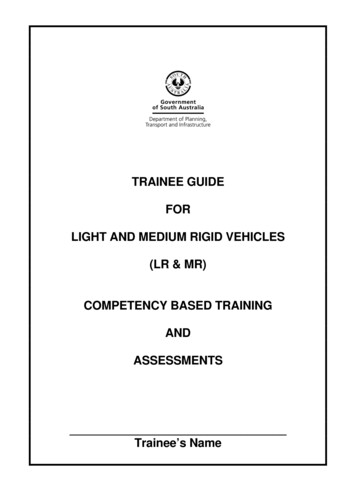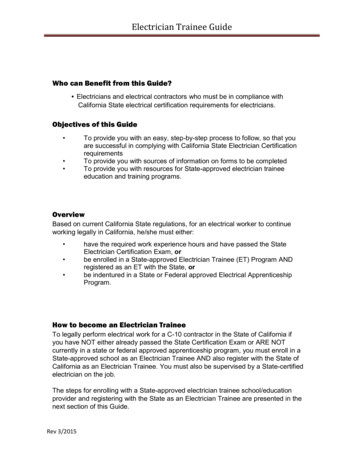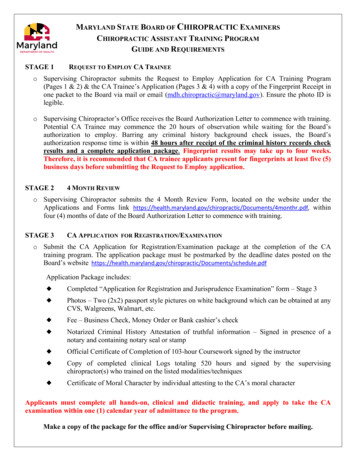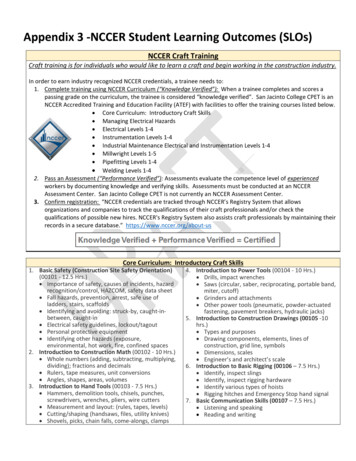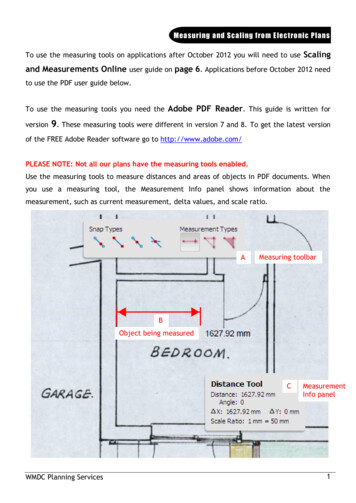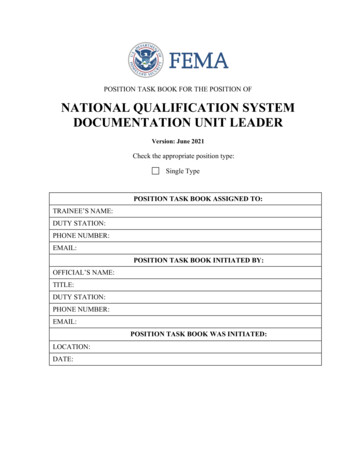
Transcription
ONLINE FIRST APRIL 16, 2021—ORIGINAL RESEARCHAutomating Measurement of Trainee Work HoursHossein Soleimani, PhD1, Julia Adler-Milstein, PhD2,3, Russell J Cucina, MD, MS1,3, Sara G Murray, MD, MAS1,3*Health Informatics, University of California, San Francisco, San Francisco, California; 2Center for Clinical Informatics and Improvement Research, Universityof California, San Francisco, San Francisco, California; 3Department of Medicine, University of California, San Francisco, San Francisco, California.1BACKGROUND: Medical training programs across thecountry are bound to a set of work hour regulations,generally monitored via self-report.computational method to estimate average weekly workhours across the rotation and the percentage of rotationswhere average work hours exceed the 80-hour workweek.OBJECTIVE: We developed a computational method toautomate measurement of intern and resident work hours,which we validated against self-report.RESULTS: The mean absolute error between self-reportedand EHR-derived daily work hours for first- (PGY-1),second- (PGY-2), and third- (PGY-3) year trainees were1.27, 1.51, and 1.51 hours, respectively. Using thiscomputational method, we estimated average (SD) weeklywork hours of 57.0 (21.7), 69.9 (12.2), and 64.1 (16.3) forPGY-1, PGY-2, and PGY-3 residents.DESIGN, SETTING, AND PARTICIPANTS: We includedall electronic health record (EHR) access log data betweenJuly 1, 2018, and June 30, 2019, for trainees enrolled inthe internal medicine training program. We inferred theduration of continuous in-hospital work hours by linkingEHR sessions that occurred within 5 hours as “on-campus”work and further accounted for “out-of-hospital” workwhich might be taking place at home.MAIN OUTCOMES AND MEASURES: We compareddaily work hours estimated through the computationalmethod with self-report and calculated the meanabsolute error between the two groups. We used theACONCLUSION: EHR log data can be used to accuratelyapproximate self-report of work hours, accounting forboth in-hospital and out-of-hospital work. Automationwill reduce trainees’ clerical work, improve consistencyand comparability of data, and provide more completeand timely data that training programs need. Journal ofHospital Medicine 2021;16:XXX-XXX. 2021 Society ofHospital Medicinecross the country, residents are bound to a set ofrules from the Accreditation Council for GraduateMedical Education (ACGME) designed to mini mizefatigue, maintain quality of life, and reduce fatiguerelated patient safety events. Adherence to work hours regulations is required to maintain accreditation. Among otherguidelines, residents are required to work fewer than 80 hoursper week on average over 4 consecutive weeks.1 When workhour violations occur, programs risk citation, penalties, andharm to the program’s reputation.Residents self-report their adherence to program regulations in an annual survey conducted by the ACGME.2 To collectmore frequent data, most training programs monitor residentwork hours through self-report on an electronic tracking platform.3 These data generally are used internally to identify problems and opportunities for improvement. However, self-reportapproaches are subject to imperfect recall and incomplete reporting, and require time and effort to complete.4The widespread adoption of electronic health records(EHRs) brings new opportunity to measure and promote ad-herence to work hours. EHR log data capture when users login and out of the system, along with their location and specificactions. These data offer a compelling alternative to self-reportbecause they are already being collected and can be analyzedalmost immediately. Recent studies using EHR log data toapproximate resident work hours in a pediatric hospital successfully approximated scheduled hours, but the approachwas customized to their hospital’s workflows and might notgeneralize to other settings.5 Furthermore, earlier studies havenot captured evening out-of-hospital work, which contributesto total work hours and is associated with physician burnout.6We developed a computational method that sought to accurately capture work hours, including out-of-hospital work, whichcould be used as a screening tool to identify at-risk residents androtations in near real-time. We estimated work hours, includingEHR and non-EHR work, from these EHR data and comparedthese daily estimations to self-report. We then used a heuristicto estimate the frequency of exceeding the 80-hour workweekin a large internal medicine residency program.*Corresponding Author: Sara G Murray, MD, MAS; Email: Sara.murray@ucsf.edu.The population included 82 internal medicine interns (PGY-1)and 121 residents (PGY-2 60, PGY-3 61) who rotated throughUniversity of California, San Francisco Medical Center (UCSFMC)between July 1, 2018, and June 30, 2019, on inpatient rotations.In the UCSF internal medicine residency program, interns spendFind additional supporting information in the online version of this article.Received: September 25, 2020; Revised: January 4, 2021; Accepted:February 3, 2021 2021 Society of Hospital Medicine DOI 10.12788/jhm.3607An Official Publication of the Society of Hospital MedicineMETHODSJournal of Hospital Medicine Published Online April 2021E1
Soleimani et al Automating Measurement of Trainee Work HoursOn-campus shift0On-campus shift12PM6AM6PM12AMOff-campus workFIG 1. Approach to Linking EHR Sessions to Measure the Total Workday. EHR sessions within 5 hours were linked, forming an entire on-campus workday. Out-ofhospital logins were added as individual entities.an average of 5 months per year and residents spend an average of 2 months per year on inpatient rotations at UCSFMC.Scheduled inpatient rotations generally are in 1-month blocksand include general medical wards, cardiology, liver transplant,night-float, and a procedures and jeopardy rotation where interns perform procedures at UCSFMC and serve as backup fortheir colleagues across sites. Although expected shift durationdiffers by rotation, types of shifts include regular length days,call days that are not overnight (but expected duration of work isinto the late evening), 28-hour overnight call (PGY-2 and PGY-3),and night-float.Data SourceThis computational method was developed at UCSFMC. Thisstudy was approved by the University of California, San Francisco institutional review board. Using the UCSF Epic Clarity database, EHR access log data were obtained, including all Epiclogins/logoffs, times, and access devices. Access devices identified included medical center computers, personal computers,and mobile devices.Trainees self-report their work hours in MedHub, a widelyused electronic tracking platform for self-report of resident workhours.7 Data were extracted from this database for interns andresidents who matched the criteria above. The self-report datawere considered the gold standard for comparison, because itis the best available despite its known limitations.We used data collected from UCSF’s physician schedulingplatform, AMiON, to identify interns and residents assignedto rotations at UCSF hospitals.8 AMiON also was used to capture half-days of off-site scheduled clinics and teaching, whichcount toward the workday but would not be associated withon-campus logins.Developing a Computational Method to MeasureWork HoursWe developed a heuristic to accomplish two goals: (1) infer theduration of continuous in-hospital work hours while providingclinical care and (2) measure “out-of-hospital” work. Logins frommedical center computers were considered to be “on-campus”work. Logins from personal computers were considered to be“out-of-hospital.” “Out-of-hospital” login sessions were furthersubdivided into “out-of-hospital work” and “out-of-hospitalstudy” based on activity during the session; if any work activitiesE2Journal of Hospital Medicine Published Online April 2021 listed in Appendix Table 1 were performed, the session was attributed to work. If only chart review was performed, the sessionwas attributed to study and did not count towards total hoursworked. Logins from mobile devices also did not count towardstotal hours worked.We inferred continuous in-hospital work by linking on-campusEHR sessions from the first on-campus login until the laston-campus logoff (Figure 1). Based on our knowledge of workflows, residents generally print their patient lists when they arriveat the hospital and use the EHR to update hand-off informationbefore they leave. To computationally infer a continuous workday, we determined the maximum amount of time between anon-campus logoff and a subsequent on-campus login that couldbe inferred as continuous work in the hospital. We calculated theprobability that an individual would log in on-campus again atany given number of hours after they last logged out (AppendixFigure 1). We found that for any given on-campus logoff, therewas a 93% chance an individual will log in again from on-campuswithin the next 5 hours, indicating continuous on-campus work.However, after more than 5 hours have elapsed, there is a 90%chance that at least 10 hours will elapse before the next on-campus login, indicating the break between on-campus workdays.We therefore used 5 hours as the maximum interval betweenon-campus EHR sessions that would be linked together to classify on-campus EHR sessions as a single workday. This windowaccounts for resident work in direct patient care, rounds, andother activities that do not involve the EHR.If there was overlapping time measurement between oncampus work and personal computer logins (for example, a resident was inferred to be doing on-campus work based on frequent medical center computer logins but there were also logins from personal computers), we inferred this to indicate that apersonal device had been brought on-campus and the time wasonly attributed to on-campus work and was not double countedas out-of-hospital work. Out-of-hospital work that did not overlap with inferred on-campus work time contributed to the totalhours worked in a week, consistent with ACGME guidelines.Our internal medicine residents work at three hospitals: UCSFMC and two affiliated teaching hospitals. Although this studymeasured work hours while the residents were on an inpatientrotation at UCSFMC, trainees also might have occasional halfday clinics or teaching activities at other sites not capturedby these EHR log data. The allocated time for that scheduledAn Official Publication of the Society of Hospital Medicine
Automating Measurement of Trainee Work Hours Soleimani et alTABLE 1. Total Days Worked at UCSFMC, Number of Rotations Worked at UCSFMC, Total Days With Self-ReportedHours, and Proportion of Days for Which There Was Self-ReportingNo. of days workedat UCSFMCNo. of rotations workedat UCSFMCNo. of days worked at UCSFMCwith self-reported hoursPercentage of days worked at UCSFMCwith self-reported hoursPGYTotalMean (SD)per traineeTotalMean (SD)per traineeTotalMean (SD)per traineeOverallMean (SD)per trainee18445103.0 (19.4)4065.0 (1.5)540187.1 (29.1)64.060.2 (40.7)2348858.1 (19.2)1402.4 (0.8)268847.2 (21.9)77.175.1 (30.4)3267744.6 (20.5)951.7 (0.8)167230.4 (20.2)62.561.9 (36.7)Abbreviations: PGY, postgraduate year; UCSFMC, University of California, San Francisco Medical Center.activity (extracted from AMiON) was counted as work hours. Ifthe trainee was assigned to a morning half-day of off-site work(eg, didactics), this was counted the same as an 8 am to noonon-campus EHR session. If a trainee was assigned an afternoonhalf-day of off-site work (eg, a non-UCSF clinic), this was countedthe same as a 1 pm to 5 pm on-campus EHR session. Counting thisscheduled time as an on-campus EHR session allowed half-daysof off-site work to be linked with inferred in-hospital work.Comparison of EHR-Derived Work Hours Heuristicto Self-ReportBecause resident adherence with daily self-report is imperfect,we compared EHR-derived work to self-report on days whenboth were available. We generated scatter plots of EHR-derivedwork hours compared with self-report and calculated the meanabsolute error of estimation. We fit a linear mixed-effect modelfor each PGY, modeling self-reported hours as a linear functionof estimated hours (fixed effect) with a random intercept (randomeffect) for each trainee to account for variations among individuals. StatsModels, version 0.11.1, was used for statistical analyses.9We reviewed detailed data from outlier clusters to understandsituations where the heuristic might not perform optimally. Toassess whether EHR-derived work hours reasonably overlappedwith expected shifts, 20 8-day blocks from separate interns andresidents were randomly selected for qualitative detail review incomparison with AMiON schedule data.Estimating Hours Worked and Work Hours ViolationsAfter validating against self-report on a daily basis, we usedour heuristic to infer the average rate at which the 80-hourworkweek was exceeded across all inpatient rotations at UCSFMC. This was determined both including “out-of-hospital”work as derived from logins on personal computers and excluding it. Using the estimated daily hours worked, we builta near real-time dashboard to assist program leadership withidentifying at-risk trainees and trends across the program.RESULTSData from 82 interns (PGY-1) and 121 internal medicine residents (PGY-2 and PGY-3) who rotated at UCSFMC between July1, 2018, and June 30, 2019, were included in the study. Table 1shows the number of days and rotations worked at UCSFMCas well as the frequency of self-report of work hours accordingAn Official Publication of the Society of Hospital Medicineto program year. Figure 2 shows scatter plots for self-reportof work hours compared with work hours estimated from ourcomputational method. The mean absolute error in estimationof self-report with the heuristic is 1.38 hours. Explanations foroutlier groups also are described in Figure 2. Appendix Figure2 shows the distribution of the differences between estimatedand self-reported daily work hours.Qualitative review of EHR-derived data compared withschedule data showed that, although residents often reportedhomogenous daily work hours, EHR-derived work hours often varied as expected on a day-to-day basis according to theschedule (Appendix Table 2).Because out-of-hospital EHR use does not count as work ifdone for educational purposes, we evaluated the proportion ofout-of-hospital EHR use that is considered work and found that67% of PGY-1, 50% of PGY-2, and 53% of PGY-3 out-of-hospitalsessions included at least one work activity, as denoted in Appendix Table 1. Out-of-hospital work therefore represented 85% ofPGY-1, 66% of PGY-2, and 73% of PGY-3 time spent in the EHRout-of-hospital. These sessions were counted towards work hoursin accordance with ACGME rules and included 29% of PGY-1 workdays and 21% of PGY-2 and PGY-3 workdays. This amounted to amedian of 1.0 hours per day (95% CI, 0.1-4.6 hours) of out-of-hospital work for PGY-1, 0.9 hours per day (95% CI, 0.1-4.1 hours) forPGY-2, and 0.8 hours per day (95% CI, 0.1-4.7 hours) for PGY-3residents. Out-of-hospital logins that did not include work activities, as denoted in Appendix Table 1, were labeled out-of-hospital study and did not count towards work hours; this amounted to a median of 0.3 hours per day (95% CI, 0.02-1.6 hours) forPGY-1, 0.5 hours per day (95% CI, 0.04-0.25 hours) for PGY-2, and0.3 hours per day (95% CI, 0.03-1.7 hours) for PGY-3. Mobile device logins also were not counted towards total work hours, witha median of 3 minutes per day for PGY-1, 6 minutes per day forPGY-2, and 5 minutes per day for PGY-3.The percentage of rotation months where average hoursworked exceeded 80 hours weekly is shown in Table 2. Inclusionof out-of-hospital work hours substantially increased the frequency at which the 80-hour workweek was exceeded. The frequencyof individual residents working more than 80 hours weekly on average is shown in Appendix Figure 3. A narrow majority of PGY-1and PGY-2 trainees and a larger majority of PGY-3 trainees neverworked in excess of 80 hours per week when averaged over thecourse of a rotation, but several trainees did on several occasions.Journal of Hospital Medicine Published Online April 2021E3
Soleimani et al Automating Measurement of Trainee Work HoursReported daily work hoursPGY-1 -- MAE 1.27FE slope: 0.73 (0.01)FE int.: 3.31 (0.11), RE int.: 0.32 (0.04)PGY-2 -- MAE 1.51FE slope: 0.70 (0.01)FE int.: 3.97 (0.16), RE int.: 0.35 (0.04)25252020PGY-3 -- MAE 1.51FE slope: 0.72 (0.01)FE int.: 3.74 (0.19), RE int.: 0.40 0250Estimated dailywork hours51015Estimated dailywork hours20250510152025Estimated dailywork hoursFIG 2. Daily Work Hours Estimated With the Computational Heuristic in Comparison to Self-Report. Mean absolute error (MAE) per year is shown in the graph. Thelinear regression line indicates the computational heuristic overestimates daily work hours when self-reported hours are large and underestimates when small. Wereport the fixed effect (FE) slope and intercept coefficients and the random effect intercept (RE) along with their corresponding standard error in the graph. Outliergroups: (A) The cohort of PGY-1 interns where the heuristic appears to underestimate self-report is largely made up of a backup rotation where residents may coverfor sick colleagues at other hospitals. (B) The cohort of PGY-2 and PGY-3 residents where the heuristic appears to underestimate self-report is largely comprised ofa UCSF-based night-float rotation where they might work at other hospitals, and, in rare cases, prolonged overnight electronic health record silence while residentswere sleeping for long periods in the hospital while on-call. (C) The cohort of PGY-2 and PGY-3 in which the heuristic appears to overestimate work hours are largelycircumstances where residents are working nightshifts but attribute all work hours to 1 day rather than splitting time before and after midnight.Estimations from the computational method were built intoa dashboard for use as screening tool by residency programdirectors (Appendix Figure 4).DISCUSSIONEHR log data can be used to automate measurement of trainee work hours, providing timely data to program directors foridentifying residents at risk of exceeding work hours limits. Wedemonstrated this by developing a data-driven approach to linkon-campus logins that can be replicated in other training programs. We further demonstrated that out-of-hospital work substantially contributed to resident work hours and the frequencywith which they exceed the 80-hour workweek, making it a critical component of any work hour estimation approach. Inclusiveof out-of-hospital work, our computational method found thatresidents exceeded the 80-hour workweek 10% to 21% of thetime, depending on their year in residency, with a small majorityof residents never exceeding the 80-hour workweek.Historically, most ACGME residency programs have relied onresident self-report to determine work hours.3 The validity of thismethod has been extensively studied and results remain mixed;in some surveys, residents admit to underreporting their hourswhile other validation studies, including the use of clock-in andclock-out or time-stamped parking data, align with self-reportrelatively well.10-12 Regardless of the reliability of self-report, it isa cumbersome task that residents have difficulty adhering to,as shown in our study, where only slightly more than one-half ofthe days worked had associated self-report. By relying on resident self-report, we are adding to the burden of clerical work,which is associated with physician burnout.13 Furthermore, because self-report typically does not happen in real-time, it limitsa program’s ability to intervene on recent or impending workhour violations. Our computational method enabled us to buildE4Journal of Hospital Medicine Published Online April 2021 a dashboard that is updated daily and provides critical insightinto resident work hours at any time, without waiting for retrospective self-report.Our study builds on previous work by Dziorny et al usingEHR log data to algorithmically measure in-hospital work.5 Intheir study, the authors isolated shifts with a login gap of 4hours and then combined shifts according to a set of heuristics. However, their logic integrated an extensive workflowanalysis of trainee shifts, which might limit generalizability.5Our approach computationally derives the temporal threshold for linking EHR sessions, which in our data was 5 hoursbut might differ at other sites. Automated derivation of thisthreshold will support generalizability to other programs andsites, although programs will still need to manually accountfor off-site work such as didactics. In a subsequent study evaluating the 80-hour workweek, Dziorny et al evaluated shiftduration and appropriate time-off between shifts and foundsystematic underreporting of work.14 In our study, we prioritized evaluation of the 80-hour workweek and found general alignment between self-report and EHR-derived workhour estimates, with a tendency to underestimate at lowerreported work hours and overestimate at higher reportedwork hours (potentially because of underreporting as illustrated by Dziorny et al). We included the important out-ofhospital logins as discrete work events because out-ofhospital work contributes to the total hours worked and tothe number of workweeks that exceed the 80-hour workweek,and might contribute to burnout.15 The incidence of exceeding the 80-hour workweek increased by 7% to 8% across allresidents when out-of-hospital work was included, demonstrating that tools such as ResQ (ResQ Medical) that rely primarily on geolocation data might not sufficiently capture theways in which residents spend their time working.16An Official Publication of the Society of Hospital Medicine
Automating Measurement of Trainee Work Hours Soleimani et alTABLE 2. Impact of Out-Of-Hospital Work on the Percentage of Rotation Months That Exceed the 80-Hour WorkweekWithout out-of-hospital workIncluding out-of-hospital workMean (SD) weeklywork hoursRate (95% CI) of exceeding80 hours /week, %Mean (SD) weeklywork hoursRate (95% CI) of exceeding80 hours per week, %154.8 (20.8)7.0 (5.0-10.1)57.0 (21.7)15.0 (11.9-18.3)268.3 (11.9)13.0 (8.3-19.4)69.9 (12.2)21.4 (14.4-28.9)362.3 (15.9)3.0 (1.1-8.9)64.1 (16.3)10.5 (5.8-18.3)PGYOur approach has limitations. We determined on-campusvs out-of-hospital locations based on whether the login devicebelonged to the medical center or was a personal computer.Consequently, if trainees exclusively used a personal computer while on-campus and never used a medical center computer, we would have captured this work done while loggedinto the EHR but would not have inferred on-campus work.Although nearly all trainees in our organization use medicalcenter computers throughout the day, this might impact generalizability for programs where trainees use personal computers exclusively in the hospital. Our approach also assumestrainees will use the EHR at the beginning and end of theirworkdays, which could lead to underestimation of work hoursin trainees who do not employ this practice. With regards towork done on personal computers, our heuristic required thatat least one work activity (as denoted in Appendix Table 1)be included in the session in order for it to count as work.Although this approach allows us to exclude sessions wheretrainees might be reviewing charts exclusively for educationalpurposes, it is difficult to infer the true intent of chart review.There might be periods of time where residents are doing in-hospital work but more than 5 hours elapsed betweenEHR user sessions. As we have started adapting this computational method for other residency programs, we haveadded logic that allows for long periods of time in the operating room to be considered part of a continuous workday. There also are limitations to assigning blocks of timeto off-site clinics; clinics that are associated with after-hourswork but use a different EHR would not be captured in totalout-of-hospital work.Although correlation with self-report was good, we identified clusters of inaccuracy. This likely resulted from our residency program covering three medical centers, two of whichwere not included in the data set. For example, if a residenthad an off-site clinic that was not accounted for in AMiON,EHR-derived work hours might have been underestimatedrelative to self-report. Operationally leveraging an automated system for measuring work hours in the form of dashboards and other tools could provide the impetus to ensureaccurate documentation of schedule anomalies.CONCLUSIONImplementation of our EHR-derived work-hour model will allow ACGME residency programs to understand and act upontrainee work-hour violations closer to real time, as the data ex-An Official Publication of the Society of Hospital Medicinetraction is daily and automated. Automation will save busy residents a cumbersome task, provide more complete data thanself-report, and empower residency programs to intervenequickly to support overworked trainees.AcknowledgmentsThe authors thank Drs Bradley Monash, Larissa Thomas, and Rebecca Bermanfor providing residency program input.Disclosures: The authors have nothing to disclose.References1. Accreditation Council for Graduate Medical Education. Common programrequirements. Accessed August 12, 2020. on-Program-Requirements2. Accreditation Council for Graduate Medical Education. Resident/fellowand faculty surveys. Accessed August 12, 2020. dent-Fellow-and-Faculty-Surveys3. Petre M, Geana R, Cipparrone N, et al. Comparing electronic and manual tracking systems for monitoring resident duty hours. Ochsner J.2016;16(1):16-21.4. Gonzalo JD, Yang JJ, Ngo L, Clark A, Reynolds EE, Herzig SJ. Accuracy ofresidents’ retrospective perceptions of 16-hour call admitting shift compliance and characteristics. Grad Med Educ. 2013;5(4):630-633. https://doi.org/10.4300/jgme-d-12-00311.15. Dziorny AC, Orenstein EW, Lindell RB, Hames NA, Washington N, DesaiB. Automatic detection of front-line clinician hospital shifts: a novel use ofelectronic health record timestamp data. Appl Clin Inform. 768196. Gardner RL, Cooper E, Haskell J, et al. Physician stress and burnout:the impact of health information technology. J Am Med Inform Assoc.2019;26(2):106-114. https://doi.org/10.1093/jamia/ocy1457. MedHub. Accessed April 7, 2021. https://www.medhub.com8. AMiON. Accessed April 7, 2021. https://www.amion.com9. Seabold S, Perktold J. Statsmodels: econometric and statistical modelingwith python. Proceedings of the 9th Python in Science Conference. /pdfs/seabold.pdf10. Todd SR, Fahy BN, Paukert JL, Mersinger D, Johnson ML, Bass BL. How accurate are self-reported resident duty hours? J Surg Educ. .2009.08.00411. Chadaga SR, Keniston A, Casey D, Albert RK. Correlation between self-reported resident duty hours and time-stamped parking data. J Grad MedEduc. 2012;4(2):254-256. https://doi.org/10.4300/JGME-D-11-00142.112. Drolet BC, Schwede M, Bishop KD, Fischer SA. Compliance and falsificationof duty hours: reports from residents and program directors. J Grad MedEduc. 2013;5(3):368-373. https://doi.org/10.4300/JGME-D-12-00375.113. Shanafelt TD, Dyrbye LN, West CP. Addressing physician burnout: the wayforward. JAMA. 2017;317(9):901. https://doi.org/10.1001/jama.2017.007614. Dziorny AC, Orenstein EW, Lindell RB, Hames NA, Washington N, Desai B.Pediatric trainees systematically under-report duty hour violations comparedto electronic health record defined shifts. PLOS ONE. al.pone.022649315. Saag HS, Shah K, Jones SA, Testa PA, Horwitz LI. Pajama time: working afterwork in the electronic health record. J Gen Intern Med. 6-019-05055-x16. ResQ Medical. Accessed April 7, 2021. https://resqmedical.comJournal of Hospital Medicine Published Online April 2021E5
We used data collected from UCSF's physician scheduling platform, AMiON, to identify interns and residents assigned to rotations at UCSF hospitals.8 AMiON also was used to cap-ture half-days of off-site scheduled clinics and teaching, which count toward the workday but would not be associated with on-campus logins.
